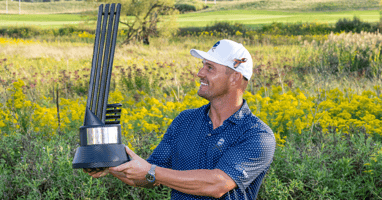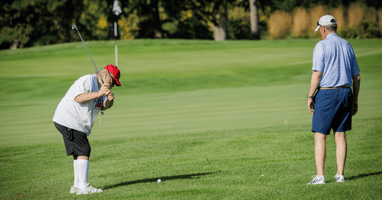Following his dramatic U.S. Open victory, three-time Illinois winner returns to defend his LIV Golf...
April 2024 - Our "Guy" at the Masters
Chicago-based cameraman a fixture at the 12th tee
Photographs by Charles Cherney
This article appeared in the April 2024 edition of Chicago District Golfer.
To read more Chicago District Golfer stories, head to our article archive.

The Masters is coming and Chicago’s “gotta guy” in the heart of Amen Corner. Champaign native, Chicago resident and five-time Emmy Award winner Kirk Hepburn will be sitting in his perch located in a tower 12 feet above the ground to the golfer’s right of the tee at the diabolical 150-yard par-3 12th, working his camera magic for CBS as he has since 1997.
Maybe you remember 1997 – or have access to it on YouTube. It was the year that 21-year-old Tiger Woods won the Masters by a record-shattering 12 shots, became a worldwide superstar and changed the game of golf forever. What a way for Hepburn, now 62 and a CDGA member, to start a Masters career that has lasted 28 years and counting.
“There was a frenzy on Sunday of unbelievable proportions,” Hepburn recalled. “The electricity through the crowd…Just walking in the streets or in the restaurants and bars that week in Augusta. The [CBS] crew was like that, too. We knew we were on to something. There are different types of great moments, and this one was white hot. This is what you make steel with.”
He was there in 2016, too, when Jordan Spieth, seemingly en route to defending his Masters title, made a quadruple-bogey 7 at the 12th, rinsing his tee shot and his third, hitting his fourth into the greenside bunker and two-putting. After leading the tournament for three-and-a-half rounds, Spieth shot 1-over 73 in the final round and concluded his day by sliding a green jacket onto the shoulders of Englishman Danny Willett. Hepburn captured it all.
“The thing that shocked all the camera guys out there was that for his third shot he backed up into the 13th fairway. Not just off the tee box, he was up in 13 fairway. There’s a little scoreboard that’s right there at 13 and he was almost parallel to it,” Hepburn remembered. “Now, he’s trying to hit a stamp at 100 yards [actually 80] and he just hit it short [into the water], and he just watched it unfold…It was hard to watch.”
 Kirk Hepburn has covered the Maters for CBS since 1997. Above is a sampling of some of his credentials from over the years.
Kirk Hepburn has covered the Maters for CBS since 1997. Above is a sampling of some of his credentials from over the years.
Then there was Tiger’s triumphant return in 2019, 22 years after he and Hepburn started together at Augusta National. What happened at 12 all but decided the tournament. Brooks Koepka and Francesco Molinari dumped their tee shots into Rae’s Creek while Woods hit his onto the center of the green and two-putted for par.
“When Koepka was coming down for his strike, there was a gust [of wind] that hit my camera, which is about 12 feet off the ground. And that gust hit the ball…That was why the ball didn’t make it [across the water hazard]. [Koepka] probably didn’t feel it…The higher you get in the air, the windier it gets. Then, of course, Tiger hits third, and being the brilliant, experienced veteran golfer that he is, puts it in the middle and makes par. Nobody else did. That was the turn. Small things like that sit in your head.” Woods went on to win his fifth Masters and 15th major championship.
At any given time, more than 100 million people from around the world could be watching Hepburn’s camera work in the middle of the action at Amen Corner. One wonders if he ever gets unnerved by those numbers.
“You can’t get in your head and worry about that,” he says. “In our viewfinder, we have a red “tally” light that kicks on and says you’re on the air. [The shot] is being seen by 12 million people, 20 million, 100 million people in the world? You can’t let that get into your head. Just do your job like you’re supposed to. When you start thinking along those lines, then you start overthinking, and when you start overthinking that makes it… [difficult].”
Masters coverage has changed completely over the years. At one time, CBS broadcast only the back nine (or as Masters officials now prefer, “the second nine”). Today, Masters.com broadcasts virtually everything, such as featured holes, including Amen Corner, that famous stretch of the 11th green, the par-3 12th and the tee shot on No. 13.
“The Masters has gone to streaming, which CBS has helped with. When I do Masters.com, I have a completely different director, completely different truck that just does 11, 12 and 13.”
 "[The shot] is being seen by 12 million people in the world? you can't let that get into your head. Just do you job like you're supposed to do." -Kirk Hepburn
"[The shot] is being seen by 12 million people in the world? you can't let that get into your head. Just do you job like you're supposed to do." -Kirk Hepburn
The golf TV business has changed a lot, too. When Hepburn started, the networks were in the process of changing their business models, eliminating their full-time staff cameramen for cost savings purposes and moving to freelancers, who weren’t eligible for company health coverage, pensions and other benefits. Hepburn was one of the new breed.
“There was a little resentment,” he said.
Which is why he operates his own business, enabling him to cover five Super Bowls, 12 Olympics and more figure skating than anyone else in the business. Remember Tonya Harding’s assault and battery on Nancy Kerrigan before the ’94 Lillehammer Games? Hepburn was there.
“I did so much figure skating, it helped pay for my house!” he said.
His first golf gig was the 1996 PGA Championship, the last for legendary CBS director Frank Chirkinian, “the father of televised golf.” He has worked for NBC for many years, including the 2012 Ryder Cup at Medinah.
Nevertheless, CBS maintains the highest standards at Augusta National. “The golf crew out there is a who’s-who of golf camera operators,” Hepburn said. “Another [camera] guy over at 12 has been there for over 30 years. Only the second guy that’s ever run that camera at the Masters. He follows that ball in. So, when you watch, watch how steady all his moves are. [The director] will go to my shot at the tee box, let’s say, and I’m head-to-toe on the player. They zoom in to an away shot for reaction. They cut to him live and now he’s got the tally light. He lands the ball, widens very softly, showing that awesome little 12th hole reverse angle, and then they [the golfers] come up there to putt…It’s not easy for camera operators to do that.”
Hepburn has a million stories. Who wouldn’t?
Inevitably, the conversation turns to LIV Golf. According to Hepburn, it’s been a boon for camera operators and other behind-the-scenes TV crews thanks to increased demand for their services. Because LIV does shotgun starts, they need cameras on 18 of the 18 holes for their TV broadcasts plus hand-helds and others, Hepburn explained.
“Each one of the LIV shows is about 40 camera operators every week for their shows, 40 camera technicians, audio department, video department, tape room. They’re pulling those people from the PGA Tour. Because of that, the money is better, because if LIV wants those people, you have to do something to lure them over there.”
In an industry, which like many others, is under a cost-cutting siege, LIV is good news.
Barry Cronin is the editor of Chicago District Golfer.




